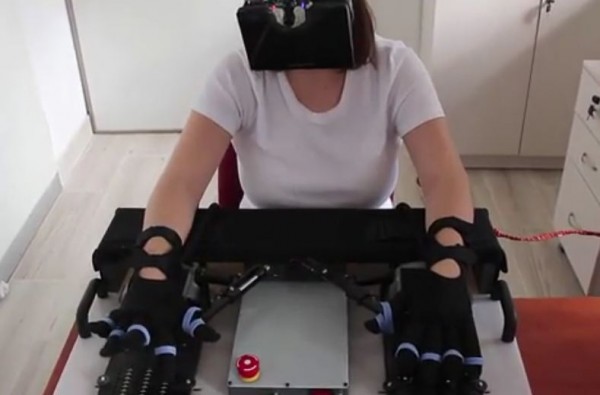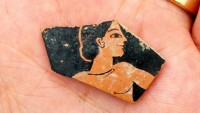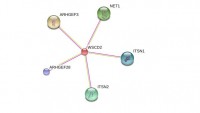Yes, Your Left Hand Knows what Your Right Hand is Doing, says Study
| Arthur Dominic Villasanta | | Dec 14, 2016 11:45 PM EST |
(Photo : Ossmy and Mukamel/Cell Reports 2017) A participant wearing special gloves that passively move the left hand to match the motions of the right hand, while the participant receives visual feedback from the virtual reality headset.
The adage,"Your left hand doesn't know what your right hand is doing," might be in for a re-working, thanks to a study conducted by researchers at Tel-Aviv University in Israel.
Researchers found that when people practiced finger movements with their right hand while watching their left hand on 3D virtual reality headsets, they could use their left hand more efficiently after the exercise.
Like Us on Facebook
The work provides a new strategy to improve physical therapy for people with limited strength in their hands. It was published Dec. 13 in the journal, Cell Reports.
"We are tricking the brain," said lead author Roy Mukamel, a professor of psychology at Tel Aviv University.
"This entire experiment ended up being a nice demonstration about how to combine software engineering and neuroscience."
After completing baseline tests to assess the initial motor skills of each hand, 53 participants strapped on virtual reality headsets, which showed simulated versions of their hands.
During the first experiment, participants completed a series of finger movements with their right hand while the screen showed their virtual left hand moving instead. They then put a motorized glove on their left hand, which moved their fingers to match the motions of the right hand.
While this occurred, the headsets again showed their virtual left hand moving instead of their right.
After analyzing the results, researchers discovered that the left hand's performance significantly improved (i.e., had more precise movements in a faster amount of time) when the screen showed the left hand.
But the most notable improvements occurred when the virtual reality screen showed the left hand moving while the motorized glove moved the right hand in reality.
The researchers also used fMRI to track which brain structures were activated during the experiments in 18 of the participants.
They noted that one section of the brain called the superior parietal lobe was activated in each person during training.
They also discovered that the level of activity in this brain region was correlated to the level of improved performance in the left hand--the more activity, the better the left hand performed.
"Technologically these experiments were a big challenge," said Mukamel.
"We manipulated what people see and combined it with the passive movement of the hand to show that our hands can learn when they're not moving under voluntary control."
Researchers are optimistic their research can be applied to patients in physical therapy programs that have lost the strength or control of their hands.
"We need to show a way to obtain high-performance gains relative to other traditional types of therapies," said Mukamel.
"If we can train one hand without voluntarily moving it and still show significant improvements in the motor skills of that hand, then that's the ideal."
TagsLeft hand, right hand, Tel-Aviv University, physical therapy, superior parietal lobe
©2015 Chinatopix All rights reserved. Do not reproduce without permission
EDITOR'S PICKS
-

Did the Trump administration just announce plans for a trade war with ‘hostile’ China and Russia?
-

US Senate passes Taiwan travel bill slammed by China
-

As Yan Sihong’s family grieves, here are other Chinese students who went missing abroad. Some have never been found
-

Beijing blasts Western critics who ‘smear China’ with the term sharp power
-

China Envoy Seeks to Defuse Tensions With U.S. as a Trade War Brews
-

Singapore's Deputy PM Provides Bitcoin Vote of Confidence Amid China's Blanket Bans
-

China warns investors over risks in overseas virtual currency trading
-

Chinese government most trustworthy: survey
-

Kashima Antlers On Course For Back-To-Back Titles
MOST POPULAR
LATEST NEWS
Zhou Yongkang: China's Former Security Chief Sentenced to Life in Prison

China's former Chief of the Ministry of Public Security, Zhou Yongkang, has been given a life sentence after he was found guilty of abusing his office, bribery and deliberately ... Full Article
TRENDING STORY

China Pork Prices Expected to Stabilize As The Supplies Recover

Elephone P9000 Smartphone is now on Sale on Amazon India

There's a Big Chance Cliffhangers Won't Still Be Resolved When Grey's Anatomy Season 13 Returns

Supreme Court Ruled on Samsung vs Apple Dispute for Patent Infringement

Microsoft Surface Pro 5 Rumors and Release Date: What is the Latest?














